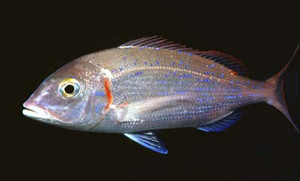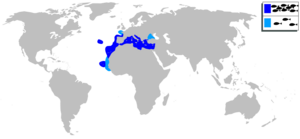Common pandora facts for kids
Quick facts for kids Common pandora |
|
|---|---|
 |
|
| Conservation status | |
| Scientific classification | |
 |
|
| Distribution of Pagellus erythrinus | |
| Synonyms | |
|
The common pandora (Pagellus erythrinus) is a cool type of fish that lives in the ocean. It's also known by other names like king of the breams or red pandora. This fish belongs to a group called Sparidae, which includes many kinds of seabreams. You can find the common pandora in the eastern Atlantic Ocean and the Mediterranean Sea. People really like to eat this fish!
Contents
About the Common Pandora's Name
Every living thing has a scientific name, like a special code. The common pandora was first given its scientific name, Sparus erythrinus, by a famous scientist named Carl Linnaeus way back in 1758. He wrote about it in his book, Systema Naturae.
The common pandora's scientific name, erythrinus, means "red". This is a good name because the fish often has a pretty pinkish-red color!
What Does the Common Pandora Look Like?
The common pandora has an oval-shaped body that looks a bit flattened from side to side. Its head is fairly straight on top. Its eyes are smaller than its snout.
Scales and Fins
The scales on its head reach up to the front of its eyes. Its cheeks have scales, but the area near its gill cover is smooth. The fish has a mouth with thick lips that points slightly downwards.
It has pointed teeth at the front of its jaws. At the back, it has teeth that look like molars, good for crushing food. The top jaw usually has 2 or 3 rows of these molar-like teeth. The bottom jaw has 2 rows.
The fin on its back, called the dorsal fin, has 12 strong spines and 10 or 11 soft rays. The fin on its belly, called the anal fin, has 3 spines and 8 or 9 soft rays.
Colors and Size
The common pandora is usually a bright pink color. It has small blue spots scattered on its upper sides. The top edge of its gill cover is a deep red. There's also a reddish spot at the base of its pectoral fin (the fin behind its gills). Sometimes, you might see a dark red mark at the very back of its dorsal fin.
This fish can grow up to 60 centimeters (about 2 feet) long. However, it's more common to see them around 25 centimeters (about 10 inches) long. The heaviest common pandora ever recorded weighed about 3.2 kilograms (7 pounds).
Where Do Common Pandoras Live?
The common pandora lives in a wide area along the eastern side of the Atlantic Ocean. You can find them from the coast of West Africa, near Guinea Bissau, all the way north to the Strait of Gibraltar. They also live around islands like Cape Verde, Madeira, and the Canary Islands.
They are very common throughout the Mediterranean Sea and even go into the western Black Sea. Sometimes, they travel as far north as Norway in the North Sea.
Their Home in the Ocean
These fish usually live near the bottom of the ocean, which is why they are called demersal fish. They can be found at depths of up to 300 meters (about 980 feet). However, they usually stay in shallower waters, no deeper than 100 meters (about 330 feet).
They like to live over sandy, muddy, rocky, or gravelly seabeds. Younger common pandoras tend to live closer to the shore than the older, adult fish.
How Common Pandoras Live and Grow
Common pandoras have an interesting way of growing up. They are born as females, but as they get older, they can change sex and become males! This usually happens when they are 3 to 4 years old and are between 12.8 and 20.3 centimeters long. However, sometimes you might find small males or even large females.
They lay their eggs, which is called spawning, from April to September. The busiest time for spawning is usually in May and June, but this can change depending on where they live.
What Do They Eat?
Scientists have studied what common pandoras eat. Their diet includes seven main types of food:
- Decapod crustaceans (like shrimp and crabs)
- Bivalves (like clams and mussels)
- Polychaetes (a type of worm)
- Krill (tiny shrimp-like creatures)
- Bony fishes (other small fish)
- Mysids (small crustaceans)
- Cephalopods (like small squid)
Shrimps like Alpheus dentipes and Processa canaliculata, and the polychaete worm Aphrodite aculata, are some of their favorite foods. Smaller common pandoras (13 to 21 cm long) mostly eat worms. Medium-sized fish eat a lot of shrimp and crabs. Larger fish (over 21 cm long) enjoy both shrimp/crabs and other small fish.
Fish Health
Like most animals, common pandoras can have tiny organisms called parasites living on or inside them. For example, a type of worm called Philometra filiformis can be found in the ovaries of female common pandoras.
Fishing for Common Pandoras
The common pandora is a very important fish for people who fish in the Mediterranean Sea and the Atlantic Ocean. It's a popular fish to catch and eat.
However, in some parts of the Mediterranean, there are signs that too many common pandoras are being caught. This is called overfishing. For example, in Italy, the amount of common pandoras caught dropped a lot from 2004 to 2010.
To help protect the fish, the European Union has set a rule that common pandoras must be at least 150 millimeters (about 6 inches) long to be caught and sold.
How They Are Caught
Fishermen use different ways to catch common pandoras:
- Fish traps (especially in the Canary Islands)
- Bottom trawls (large nets dragged along the seabed)
- Beach seines (nets pulled from the shore)
- Line gears (fishing with hooks and lines)
- Trammel nets and gill nets (different types of nets)
Once caught, common pandoras are sold in markets all over the Mediterranean. They are highly valued and can be sold fresh, smoked, frozen, or dried and salted. They are also used to make fish meal and fish oil. Many people also enjoy catching them for fun as recreational anglers.


